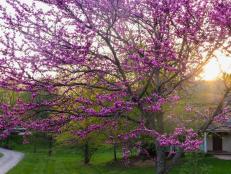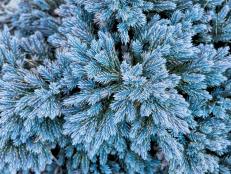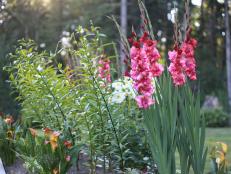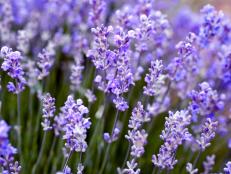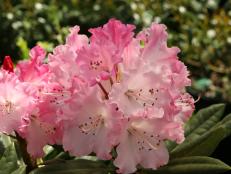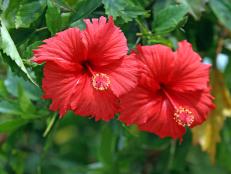How to Plant and Grow Flowering Crabapple Trees
Learn all about flowering crabapple trees, plus get expert tips and information for choosing, planting, growing and caring for crabapples in your home landscape.

Ornamental crabapples are showstoppers at any time of year, with abundant spring blooms, eye-catching winter fruit, often attractive foliage and architectural form. Serious pest and disease pressures caused these once beloved trees to fall out of favor in recent decades. Today, there are many stunning and truly disease resistant varieties on the market, which means that flowering crabapple deserves a second chance.
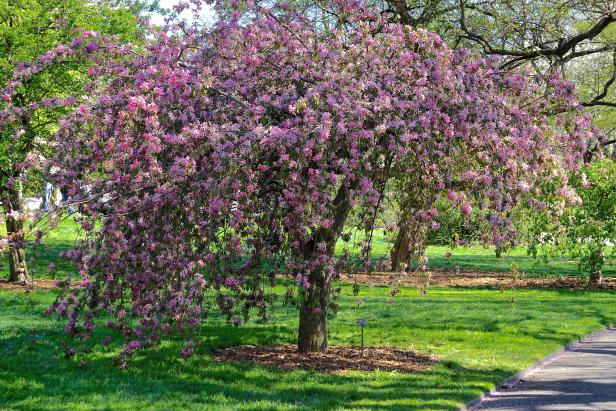
Shutterstock/Linda Harms
Botanical Name: Malus spp.
Common Name: Flowering Crabapple
Bloom Time: Spring
Light Needs: Full sun
Hardiness Zones: 4 to 7, depending on variety
Height: Usually 15 to 25 feet, but differs by variety
Growth Rate: Medium
Crabapples are fantastic mid-sized trees that are valued for their flower, fruit, foliage and form. Fragrant and abundant white, pink or red blooms develop into striking crimson or golden fruits that often persist into the winter. Foliage can be lustrous green, purple-tinged, or bronze, depending on the variety. Some crabapples even have spectacular honey yellow, apricot and burgundy fall color. Straight species usually develop broad, spreading habits, maturing up to 25 feet with an equal or greater spread, but other forms are available, including compact trees for small yards and weeping varieties.
How to Use in Your Landscape
If you’re looking for year-round curb appeal, flowering crabapples are excellent candidates for the front yard. Be sure to give plenty of space around power lines and the house so the tree can grow a symmetrical habit. Crabapple’s broad, spreading canopy can be a source of shade and privacy for overlooked backyard gardens.
15 Fast-Growing Trees 15 Photos
Crabapples grow fast. Here are 14 more trees that will liven up your yard and add shade quickly.
Crabapples stand out when planted as a single accent plant or in groups. If space allows, combine and contrast different types of crabapples. The juxtaposition of different colors and shapes can be very pleasing. Dramatic weeping crabapples should be planted as a single specimen tree to really shine out and catch the eye.
The reflection of a flowering crabapple in gently rippling water can be a source of unparalleled beauty. Crabapples hate to have wet feet, so be sure to plant trees uphill from bodies of water rather than directly next to them.
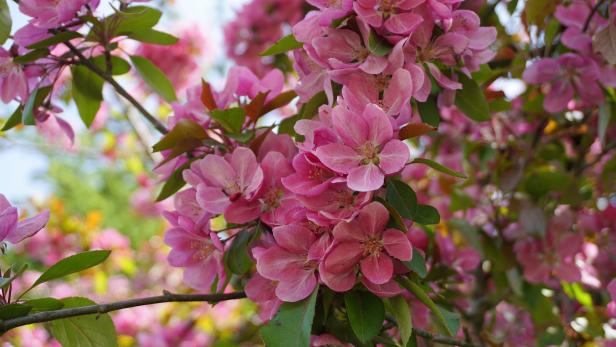
Shutterstock/lenic
How to Plant Crabapple
Crabapples look their best when they have at least 6 hours of sun a day. Although they prefer rich, moist but well-drained soils, these trees are surprisingly adaptable to many soil types. The only situation they won’t tolerate is heavy, poorly drained clay.
Plant trees in fall or early spring when the weather is cool. This will give the tree plenty of time to begin to establish roots before stressful hot, summer weather. Keep a careful eye on watering during the first season. Give young crabapples a good drink every few days during the first year, then as needed once they are established.
Crabapple Care
Pruning
Crabapples occasionally need some light pruning to increase air circulation, improve tree structure and remove suckering growth. Remove congested branches to create an open canopy. This will improve air circulation and decrease disease pressure.
Be sure to remove fast-growing suckers that may sprout from the roots around the tree and the trunk. Many crabapple trees are grafted, where the top half of the tree is selected for its flower, foliage and fruit, while the bottom is selected for hardiness and disease resistance. The vigorous rootstock may send up suckers that will eventually outcompete the top-graft but won’t have the same ornamental characteristics.
Health Problems
Unfortunately, flowering crabapples have a well-earned reputation for being plagued by insect pests and diseases. The good news is that there are many resistant varieties that will withstand those issues and often come through the season unscathed. Reach out to your state extension service to learn what selections perform the best in your area.
- Fireblight – bacterial disease causes new growth to look scorched by fire; remove diseased section by pruning several inches below affected area; sterilize tools between cuts to avoid spreading the disease; avoid using heavy nitrogen fertilizer to limit fireblight
- Cedar apple rust – this fungal disease spends half of its life cycle on junipers; yellow-orange leaf spots appear on crabapples in the spring, often leading to premature leaf drop; maintain at least 500 feet between apples and junipers to eliminate this disease from the landscape
- Apple scab – dark leathery spots appear on foliage and fruits, which are often prematurely shed by the tree; spores on fallen leaves and fruit can reinfect trees the following season; scab is more common on crowded, congested plants; follow spacing requirements for the variety and prune to maintain good air circulation in the canopy
- Canker – a fungal disease that begins as a sunken lesion on a branch and spreads to cut off circulation between the branch and the rest of the tree; this disease enters the tree through wounds in the bark, often inflicted by lawnmowers and line trimmers; remove diseased branches at least several inches below the affected area
- Scale – these stationary insects hunker down on leaves and stems, often protected by a layer of wax; control by spraying a horticultural dormant oil before bud break; check with local extension service to identify the species and time treatment
- Borers – usually prey on young trees; bore small holes into branches and the trunk on the sunny side of the tree, eventually causing oozing cracks; borers are more successful on stressed trees than vigorous ones because healthy trees usually flood borers’ chambers with sap
- Japanese beetles – skeletonize leaves and (given the right conditions) can quickly defoliate trees; research suggests these pests favor red-leaved varieties; beetle traps are available but must be placed at least 50’ away from crabapples to be effective
Popular Crabapple Varieties
With more than 20 species and at least 400 cultivated varieties, there are certainly a wealth of choices for those who are in the market for a new crabapple tree. A few popular varieties and common species are presented below.
Small-Statured Crabapples
- ‘Adirondack’ – red flower buds open to white blooms with a touch of red; the bright red fruits are very long-lasting and will persist until the end of the year in many southern gardens; upright vase-shaped habit makes this a good fit for narrow spaces; generally 10’ x 6’, although some specimens may grow larger; highly resistant to common crabapple diseases
- Coralburst – beautiful coral buds open to rose-pink blooms; bronze fruits; compact habit growing up to 15’ x 10'; may be grown as a tree or shrub; moderately susceptible to scab
- Lollipop – prolific pink buds open to white flowers; small golden fruit; matures to 8’ x 8’ with a tight, rounded canopy; disease resistant
- M. sargentii – red buds of Sargent crabapple open to fragrant white blooms; bright red fruits; grows up to 10’; very resistant to fireblight, leaf spot and Japanese beetle with moderate scab resistance
Weeping Crabapples
- ‘Manbeck Weeper’ – prolific white and pink blooms; bright red fruit; new stems are red; 12’ x 12’ with good weeping habit; very disease resistant, but may occasionally experience scab
- Molten Lava – dark red buds open to white blooms; persistent red fruits; a vigorous weeping tree that matures to 15’ x 15’; highly resistant to common diseases and Japanese beetle, although may occasionally experience fireblight and scab
- ‘White Cascade’ – pink buds open to white blooms; pea-sized lemon yellow fruits; an outstanding cascading habit; up to 15’ x 15’; high disease resistance, although may experience scab given the right conditions
For Foliage
- ‘Indian Summer’ – long-lasting rosy pink blooms; attractive, persistent red fruits; eye-catching purple-tinged foliage; matures to 18’ x 25’; highly resistant to fireblight, rust, and mildew with good resistance to scab as well
- ‘Prairifire’ (pronounced “prairie fire”) – buds open to deep pink flowers; long-lasting red-purple fruits; new foliage unfurls maroon, matures to green, and provides a mosaic of orange and red fall color; grows to 20’ x 20’; outstanding disease resistance
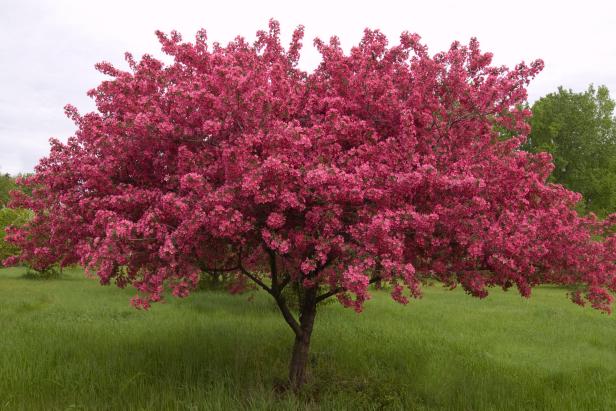
BaileyNurseries.com
Fill spring with scenes of blossom-bedecked boughs by adding ‘Prairifire’ crabapple (Malus 'Prairifire') to your yard. This quick-growing beauty works well in modern yards, staging a flower show in late spring. Blooms fade to form small apples that stay on the tree, beckoning fruit-loving birds. Disease-resistant, expect this crabapple to keep its leaves all summer long. Trees grow 15 to 20 feet tall and up to 20 feet wide. It’s hardy in Zones 4 to 7 and earned the award of 1996 Iowa Tree of the Year.
- 'Profusion' – dark red buds open to rose-pink blooms that fade to pink; long-lasting blood-red fruits; purple new growth fades to green with purple-tinged green; may develop copper fall color; fast-growing upright habit matures to 25’; susceptible to powdery mildew, scab, and fireblight
- Royal Raindrops – burgundy blooms; long-lasting red fruits; cut-leaf foliage emerges wine red and matures to red-green followed by outstanding fiery fall color; grows to 20’ x 15’; excellent disease resistance
For Long-Lasting Fruit
- 'Callaway' – an excellent choice for southern gardens; 1½” wide white blooms; long-lasting red fruits are not only ornamental, but reportedly taste good too; heavy fruit set can weigh down branches late in the season; matures to somewhere between 15’ and 25’ in height; despite good disease resistance, may be affected by fireblight and mildew in some areas
- Centurion – cold hardy selection; attractive rosy red blooms; lustrous and persistent bright red fruits; grows to 25’ x 20’ with a rounded habit at maturity; very disease resistant, although may occasionally have trouble with scab
- 'Donald Wyman' – a top pick in many crabapple evaluations; pink buds open to reveal 1¾" wide white blooms; long-lasting lustrous red fruits; matures to 20’ x 25’; very disease resistant, although may struggle with a bit of powdery mildew, scab, and fireblight in some seasons
- Red Jewel – prolific white blooms develop into bright red fruits that can last until the end of the year; matures to 15’ x 12’; very resistant to scab and fireblight with some resistance to mildew
- Sugar Tyme – high marks for long-lasting flowers, persistent fruit, and attractive foliage; pink buds open to white fragrant flowers that develop into red fruit; upright habit growing to 18’ x 15’; very resistant to common diseases with slight scab susceptibility and good Japanese beetle resistance
Other Popular Selections
- 'Dolgo' – good cold hardiness for northern gardens; pink buds open to white fragrant blooms; stunning red-purple fruits mature late in the summer and can be used in jellies; flowers every other year; matures to a large 30’ to 40’ tree with a spreading habit; some susceptibility to scab, fireblight, and frogeye leaf spot
- M. floribunda – the dark pink to red buds of Japanese crabapple open to fragrant 1½” white blooms; short-lived yellow and red fruits; especially attractive broad habit; grows to 25’ in height; susceptible to powdery mildew, scab, and fireblight, but very resistant to Japanese beetles
- Robinson – red buds open to reveal deep pink blooms; dark red fruit; grows to 25’ in height and width; susceptible to scab with some resistance to Japanese beetle
- 'Snowdrift' – pink buds open to 1¼” white blooms; abundant flowers develop into orange-red fruits; fast growing tree matures to 20’ tall and wide; fireblight is a serious problem with some susceptibility to scab as well
- 'Spring Snow' – sterile white blooms rarely develop fruit; upright tree matures to 20’ to 25’ in height; susceptible to cedar apple rust and fireblight and seriously affected by scab
- M. angustifolia – the native species to eastern North America is worth mentioning, if not for its ornamental value, then for its benefit to wildlife; pink buds open to sweet smelling white blooms; typically flowers later than other crabapples; yellow-green fruits are prized by woodland creatures and also delicious prepared in jellies, preserves and cider; sprawling tree matures to 25’ to 30’ in height; suckering habit will quickly form a thicket; troubled by cedar-apple rust









